 For each new model year, truck manufacturers are one-upping each other, and 2011 was no exception, with Ford’s F-150 receiving a much-needed boost in the engine department. With that in mind, and me being in the market for a new pickup, I drove the “Big 3” – Ford, GMC and RAM, and came up with a conclusive winner, which I ended up bring home to park in my own driveway. Continue Reading to see how things shaped up.
For each new model year, truck manufacturers are one-upping each other, and 2011 was no exception, with Ford’s F-150 receiving a much-needed boost in the engine department. With that in mind, and me being in the market for a new pickup, I drove the “Big 3” – Ford, GMC and RAM, and came up with a conclusive winner, which I ended up bring home to park in my own driveway. Continue Reading to see how things shaped up.
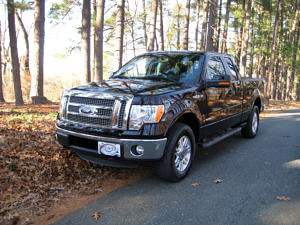 After buying a home earlier this year, it became apparent that while my wife’s Mazda Mazda6 can haul some things, it wasn’t suiting our needs quite right for bigger home projects, including landscaping and hauling firewood. With that in mind, I went shopping for a pickup truck. While a mid-sized pickup would suit our new needs, the fuel economy penalty is negligible when the smaller truck is equipped with a V6. This limited the search to the Toyota Tundra, Nissan Titan, RAM 1500, GMC Sierra 1500, and Ford F-150. The Titan didn’t have all the creature comforts I was looking for and the Tundra was in limited supply after the devastation in Japan earlier this year (so I couldn’t find one optioned out the way I liked). That left the American truck makers, and while the Chevrolet Silverado is very similar to its twin, the GMC Sierra, I prefer the looks of the Sierra, so that dropped the potential truck pool to just three.
After buying a home earlier this year, it became apparent that while my wife’s Mazda Mazda6 can haul some things, it wasn’t suiting our needs quite right for bigger home projects, including landscaping and hauling firewood. With that in mind, I went shopping for a pickup truck. While a mid-sized pickup would suit our new needs, the fuel economy penalty is negligible when the smaller truck is equipped with a V6. This limited the search to the Toyota Tundra, Nissan Titan, RAM 1500, GMC Sierra 1500, and Ford F-150. The Titan didn’t have all the creature comforts I was looking for and the Tundra was in limited supply after the devastation in Japan earlier this year (so I couldn’t find one optioned out the way I liked). That left the American truck makers, and while the Chevrolet Silverado is very similar to its twin, the GMC Sierra, I prefer the looks of the Sierra, so that dropped the potential truck pool to just three.
 During my research, I drove several trucks from GMC and Ford, as well as a RAM 1500. The RAM simply wasn’t quiet enough, even though it had the best ride of the three. Now down to two, I borrowed a 2011 GMC Sierra from my friends at King Buick GMC and drove it for a few days. It was a great experience, and gave me a taste of what my commuting life would be like behind the wheel of a full-size pickup truck. The Sierra was sized just right, and fit into normal parking spaces. It was missing the Bose stereo (which I listened to in another Sierra) and moonroof, two things I had put on my “must have” option list.
During my research, I drove several trucks from GMC and Ford, as well as a RAM 1500. The RAM simply wasn’t quiet enough, even though it had the best ride of the three. Now down to two, I borrowed a 2011 GMC Sierra from my friends at King Buick GMC and drove it for a few days. It was a great experience, and gave me a taste of what my commuting life would be like behind the wheel of a full-size pickup truck. The Sierra was sized just right, and fit into normal parking spaces. It was missing the Bose stereo (which I listened to in another Sierra) and moonroof, two things I had put on my “must have” option list.
As a refresher, take a look at the review I wrote on the 2011 Ford F-150.
For this comparison, I used my experiences behind the wheel of each truck, and as usual, I’ve found something to like in each category about both trucks. Let’s see how they stacked up:
Exterior: GMC Sierra
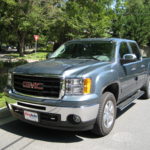 Yes, the new F-150 is a handsome truck, but the designers at GM really nailed the Sierra’s look. It’s rugged, but refined, while the Ford more closely resembles a Tonka truck. The dimensions of each truck just aren’t drastically different from each other, so this is a very subjective quality. The big difference, though, is truck height. Although Ford has stuck to a flat load floor, GM’s engineers gave their truck an actual transmission hump down the center of the cab’s floor. This lowers the overall truck height by a few inches, making it easier to get in and out of. The offset is that a flat load floor can be used to haul weather-sensitive objects such as big-screen TVs.
Yes, the new F-150 is a handsome truck, but the designers at GM really nailed the Sierra’s look. It’s rugged, but refined, while the Ford more closely resembles a Tonka truck. The dimensions of each truck just aren’t drastically different from each other, so this is a very subjective quality. The big difference, though, is truck height. Although Ford has stuck to a flat load floor, GM’s engineers gave their truck an actual transmission hump down the center of the cab’s floor. This lowers the overall truck height by a few inches, making it easier to get in and out of. The offset is that a flat load floor can be used to haul weather-sensitive objects such as big-screen TVs.
Interior: Ford F-150
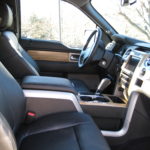 This one is close. While the faux light wood trim in the F-150 Lariat first turned me off, it has since grown on me, and has become a nice contrast to the black plastic and leather found elsewhere in the cab. Meanwhile, the wood trim on the Sierra SLT is simply classy The SLE trim level is completely different, missing the wood trim but still quite functional and more like a work truck. Whereas GM’s designers have opted for an interior that looks more at home in a Tahoe or Suburban, Ford’s people have made the Expedition more like a truck on the inside. With the 4.2″ LCD in the instrument cluster of the F-150, as well as SYNC and a better navigation system, the F-150 winds this part of the comparison.
This one is close. While the faux light wood trim in the F-150 Lariat first turned me off, it has since grown on me, and has become a nice contrast to the black plastic and leather found elsewhere in the cab. Meanwhile, the wood trim on the Sierra SLT is simply classy The SLE trim level is completely different, missing the wood trim but still quite functional and more like a work truck. Whereas GM’s designers have opted for an interior that looks more at home in a Tahoe or Suburban, Ford’s people have made the Expedition more like a truck on the inside. With the 4.2″ LCD in the instrument cluster of the F-150, as well as SYNC and a better navigation system, the F-150 winds this part of the comparison.
Capacity/Capability: F-150
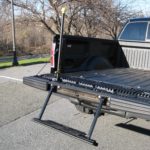 I probably won’t ever max out my F-150, in either hauling or towing. That being said, Ford’s optional tailgate step and box side steps are a phenomenal addition to any full-size truck. The tailgate step makes it really easy to get up into the truck bed, and the box side steps mean that anything that slid forward is easily retrieved. On a side note, they’re probably my wife’s favorite feature – she loves showing off how easy it is for her to get up and into the bed, even though she’s only 5’3″ tall. As a counterpoint, if you’re tall enough or don’t need to get into the bed that often, either truck will do. The steps just give the F-150 the edge. If you’re not going to tax either payload or towing capacity, you won’t miss out by picking the Sierra, so it becomes more of a personal preference.
I probably won’t ever max out my F-150, in either hauling or towing. That being said, Ford’s optional tailgate step and box side steps are a phenomenal addition to any full-size truck. The tailgate step makes it really easy to get up into the truck bed, and the box side steps mean that anything that slid forward is easily retrieved. On a side note, they’re probably my wife’s favorite feature – she loves showing off how easy it is for her to get up and into the bed, even though she’s only 5’3″ tall. As a counterpoint, if you’re tall enough or don’t need to get into the bed that often, either truck will do. The steps just give the F-150 the edge. If you’re not going to tax either payload or towing capacity, you won’t miss out by picking the Sierra, so it becomes more of a personal preference.
Power Train: F-150
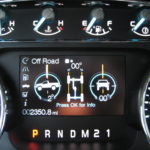 No big surprise here; the Sierra last had a redesign for the 2007 model year, and hasn’t seen any drivetrain improvements since then except the introduction of a 6-speed automatic. The powertrain options in the GMC Sierra are more than adequate though, and the cylinder deactivation is a neat trick for saving fuel. The current-generation F-150, however, was new for 2009, although it greatly resembles the 2004-2008 model, and is running on a similar platform. The big news for the F-150 is the complete revamp of the engine lineup for 2011. From a new base V6 to two new V8s, as well as the EcoBoost, the F-150 has this round wrapped up. When comparing the trucks based on engine size, the 5.0-liter V8 from Ford is down on fuel economy by 1mpg in both city and highway driving (in 4×4 guise), but is up on power – 360/380 horsepower/torque compared to 315/335 hp/tq in the Sierra’s 5.3-liter V8. If you opt for the EcoBoost V6 in the F-150, however, you match the Sierra’s fuel economy numbers for its 5.3-liter V8 in the city, but gain 1 mpg in highway driving, all the while besting its power, hauling and towing capabilities. The EcoBoost engine in the F-150 is rated at 365 horsepower and 420 ft-lbs of torque.
No big surprise here; the Sierra last had a redesign for the 2007 model year, and hasn’t seen any drivetrain improvements since then except the introduction of a 6-speed automatic. The powertrain options in the GMC Sierra are more than adequate though, and the cylinder deactivation is a neat trick for saving fuel. The current-generation F-150, however, was new for 2009, although it greatly resembles the 2004-2008 model, and is running on a similar platform. The big news for the F-150 is the complete revamp of the engine lineup for 2011. From a new base V6 to two new V8s, as well as the EcoBoost, the F-150 has this round wrapped up. When comparing the trucks based on engine size, the 5.0-liter V8 from Ford is down on fuel economy by 1mpg in both city and highway driving (in 4×4 guise), but is up on power – 360/380 horsepower/torque compared to 315/335 hp/tq in the Sierra’s 5.3-liter V8. If you opt for the EcoBoost V6 in the F-150, however, you match the Sierra’s fuel economy numbers for its 5.3-liter V8 in the city, but gain 1 mpg in highway driving, all the while besting its power, hauling and towing capabilities. The EcoBoost engine in the F-150 is rated at 365 horsepower and 420 ft-lbs of torque.
Chassis/Suspension: F-150
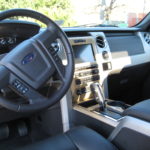 In an interesting turn of events, my research shows that while the F-150 has a fully-boxed frame (read: stronger, more rigid), its bigger brothers, the F-250 and F-350, have C-channel-based underpinnings. On the GM side of the fence, their Sierra 1500 has C-channels, while the Sierra 2500 and 3500 have fully-boxed frames. Either way, the chassis and suspension on the F-150 are a notch above the Sierra’s, so they have a similar ride, but the Ford has more composed handling. Neither truck could be confused with their grandfathers from the late 1990s.
In an interesting turn of events, my research shows that while the F-150 has a fully-boxed frame (read: stronger, more rigid), its bigger brothers, the F-250 and F-350, have C-channel-based underpinnings. On the GM side of the fence, their Sierra 1500 has C-channels, while the Sierra 2500 and 3500 have fully-boxed frames. Either way, the chassis and suspension on the F-150 are a notch above the Sierra’s, so they have a similar ride, but the Ford has more composed handling. Neither truck could be confused with their grandfathers from the late 1990s.
Creature Comforts: F-150
SYNC is an awesome voice-activated system, and it’s tied into one of the easiest-to-use infotainment systems I’ve used. The aforementioned 4.2″ LCD screen in the instrument cluster is also a big winner over the old, pixelated dashboard readouts. The sound deadening on the Sierra was pretty good, but Ford’s engineers added an extra layer, and it’s whisper quiet in the F-150, even at 70mph (I read 73dB at 70mph on a decibel meter app on my iPhone, 75dB in the Sierra). The F-150 wins by a good margin here. I liked the radio in the Sierra because it allows for AM, FM and XM to be combined in one 6-preset block. The optional Bose stereo sounds nice as well.
Overall Winner: 2011 Ford F-150
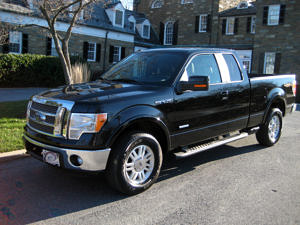 While Chevrolet’s Silverado Heavy Duty (HD) took the honors of Motor Trend’s Truck Of The Year (TOTY) for 2011, it’s no surprise why Ford’s F-150 has regained the crown for 2012. The new engines have bumped the F-150’s capability to surpass that of GMC’s Sierra, and more importantly for a lot of owners, fuel economy too. The GMC Sierra is a very attractive package though, with well thought out interior bits and a keen eye for the details. With a refresh looming for 2013 or 2014 for the Chevrolet Silverado and GMC Sierra, I expect to be revisiting this subject in short order.
While Chevrolet’s Silverado Heavy Duty (HD) took the honors of Motor Trend’s Truck Of The Year (TOTY) for 2011, it’s no surprise why Ford’s F-150 has regained the crown for 2012. The new engines have bumped the F-150’s capability to surpass that of GMC’s Sierra, and more importantly for a lot of owners, fuel economy too. The GMC Sierra is a very attractive package though, with well thought out interior bits and a keen eye for the details. With a refresh looming for 2013 or 2014 for the Chevrolet Silverado and GMC Sierra, I expect to be revisiting this subject in short order.
by John Suit
Thanks to Steve Francisco of King Buick GMC for the use of multiple 2011 GMC Sierras for this comparison and the review.

“On the GM side of the fence, their Sierra 1500 has C-channels”.
The GM 1500 trucks have had fully boxed frames since 2007.
Ooops… should have also wrote… “Thanks for the comparison!”. Sorry ’bout that.
Robert, good catch! My original sources had said the Sierra had C-channel frame members. After some further research, it appears that GM decided on boxed frame rails, but the rear ends are C-channels. They made this decision based on weight and the lack of stress the rear end takes in relation to the center section.
Correct. The last ~ 12″ of frame rail is c-channel, where the bumper attaches. I drive an ’08 Sierra, but have looked at the F150 a few times too. Like ’em both.
If you have decided on the Classy Gmc truck look me up! 719-645-9437 My name is Tracy
At Ferguson Buick Gmc in Colorado Springs! Look forward to hearing from you.